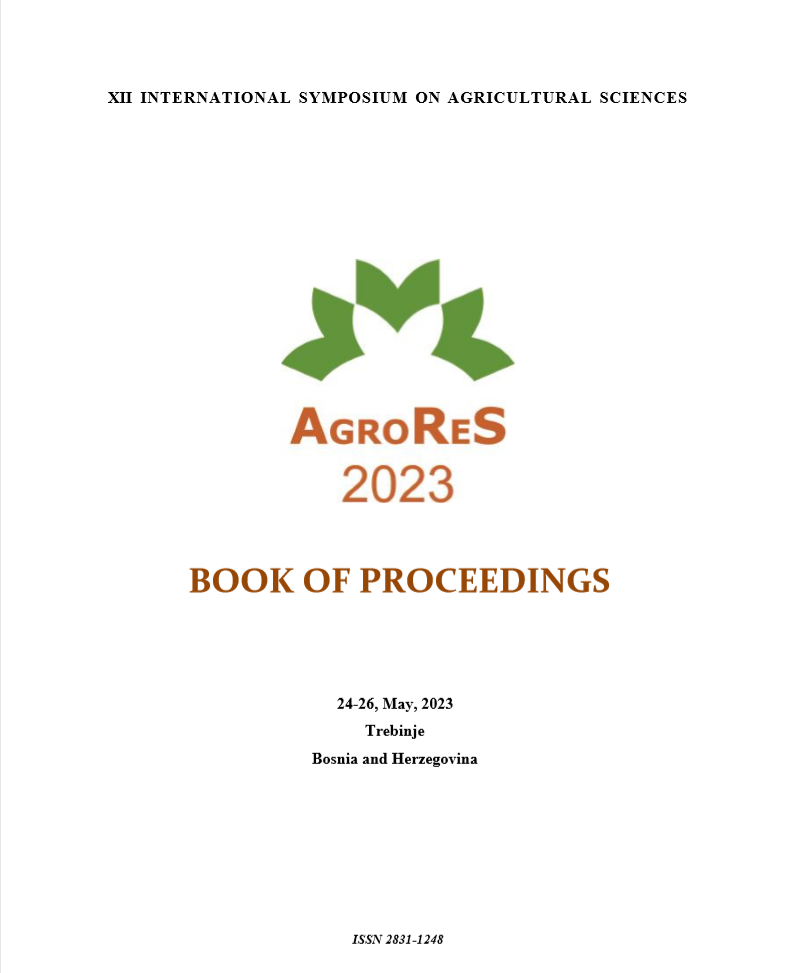Influences of Bacilus suptilis and Trichoderma harzianum to productivity and fruits quality of strawberry cultivar 'Clery'
DOI:
https://doi.org/10.7251/ZARS2301104DKeywords:
strawberry, microorganisms, fruits quality, yieldAbstract
In the study were examined an influence of different microorganisms to improve yield and quality of fruits strawberry cultivar ‘Clery’. The microbiological preparations were applied by drip irrigation system in doses of 5 l/ha, two and four weeks after planting, and also, next spring four and two weeks from the expected beginning of blooming. The following properties of productivity were analyzed: the number of crowns per plant, diameter of crowns, the number of inflorescences per crowns, the number of fruits per inflorescence, the total number of fruits per plants and the yield per plants (total and separately per harvesting in kg). According UPOV Code for strawberry the following phenological properties were studied. Plants treated with T. harzianum had significantly higher and numbers of inflorescences per crowns. A percentage of harvested fruits in first harvest, in regard to total fruits per plants, were between 19.5% (control plants) to 25.3% (B. suptilis). In the second harvest, to all treatments were recorded an increased yield of harvested fruits compared to first harvest. A total yield of marketable fruits per plants ranged between 0.38 kg (control) to 0.56 kg (T. harzianum). The highest content of TSS had fruits from plant treated with T. harzianum (10.7%), while the lowest had fruits treated with B. suptilis (10.2%). In the first harvest values of ascorbic acids in fruits ranged between 32.6 mg to 35.2 mg. Fruits from control plants had significantly higher values of AA. Generally, fruits from the second harvest had a decreased of contents of chemical properties.
References
Anuradha, S., Goyal, R.K., Sindhu, S.S. (2020). Response of strawberry (Fragaria x ananassa Duch.) to PGPR inoculation. Bangladesh Journal of Botany, 49: 1071–1076.
Bayramoglu, Z.; Selvi, T.; Esitgen, A.; Dönmez, M.F. (2020). The effect of bacterial applications on resource utilization ın strawberry (Fragaria x ananassa Duch.) production. Journal of Agriculture and Nature, 23: 1308–1313.
Chebotar, V.K., Chizhevskaya, E.P., Vorobyov, N.I., Bobkova, V.V., Pomyaksheva, L.V., Khomyakov, Y.V., Konovalov, S.N. (2022). The quality and productivity of strawberry (Fragaria × ananassa Duch.) improved by the inoculation of PGPR Bacillus velezensis BS89 in field experiments. Agronomy, 12, 2600.
Cho, H.T., Lee, R.D. (2013). Auxin, the organizer of the hormonal/environmental signals for root hair growth. Frontiers of Plant Science, 4: 448.
Duran, M., Aday, M., Zorba, N.N., Temizkan, R., Büyükcan, M., Caner, C.(2016). Potential of antimicrobial active packaging ‘containing natamycin, nisin, pomegranate and grape seed extract in chitosan coating’ to extend shelf life of fresh strawberry. Food and Bioproducts Processing, 98: 354-363.
Erturk, Y., Ercisli, S., Cakmakci, R. (2012). Yield and growth response of strawberry to plant growth-promoting rhizobacteria inoculation. Journal of Plant Nutrition, 35 (6): 817-826.
Giampieri, F., Tulipani, S., Alvarez-Suarez, J.M., Quiles, J.L., Mezzetti, B., Battino, M. (2012). The strawberry: composition, nutritional quality, and impact on human health. Nutrition, 28: 9–19.
Khirallah, W., Mouden, N., Selmaoui, K., Achbani, E., Benkirane, R., Touhami, A.O. and Douira, A. (2016): Compatibility of Trichoderma spp. with Some Fungicides under in Vitro Conditions. International Journal of Recent Scientific Research, 7, 9060-9067.
Kundan, R.,Pant, G., Jadon, N., Agrawal, P.K. (2015). Plant growth promoting rhizobacteria: mechanism and current prospective. Journal of Biofertilizers and Biopesticides, 6: 155.
Meng, Q., Jiang, H., Hao, J.J. (2016). Effects of Bacillus velezensis strain BAC03 in promoting plant growth. Biological Control, 98: 18–26.
Mikiciuk, G., Sas-Paszt, L., Mikiciuk, M., Derkowska. E., Trzciński, P., Głuszek, S., Lisek, A. Wera-Bryl, J., Rudnicka, I. (2019). Mycorrhizal frequency, physiological parameters, and yield of strawberry plants inoculated with endomycorrhizal fungi and rhizosphere bacteria. Mycorrhiza 29: 489–501.
Morais, M., Mucha, A., Ferreira, H., Gonçalves, B., Bacelara, E., Marques, G. (2019). Comparative study of plant growth promoting bacteria on the physiology, growth and fruit quality of strawberry. Journal of Science of Food and Agriculture, 99: 5341–5349.
Natsheh, B., Abu-Khalaf, N., Mousa, S. (2015): Strawberry (Fragaria x ananassa Duch.) plant productivity quality in relation to soil depth and water requirements. International Journal of Plant Research, 5: 1–6
Paliwoda, D., Mikiciuk, G., Mikiciuk, M., Kisiel, A., Sas-Paszt, L., Miller, T. (2002). Effects of Rhizosphere Bacteria on Strawberry Plants (Fragaria × ananassa Duch.) under Water Deficit. International Journal of Molecular Sciences, 23(18):10449.
Shen, H., Wei, Y., Wang, X., Xu, C., Shao, X. (2019). The marine yeast Sporidiobolus pararoseus ZMY-1 has antagonistic properties against Botrytis cinerea in vitro and in strawberry fruit. Postharvest Biology and Technology, 150: 1–8.
Vejan, P., Abdullah, R., Khadiran, T., Ismail, S., Nasrulhaq, B.A. (2016). Role ofplant growth promoting rhizobacteria in agricultural sustainability: a review. Molecules, 21: 573.
Zahir, Z.A., Arshad, M., Frankenberger, W.T. (2004). Plant growth promoting rhizobacteria: applications and perspectives in agriculture. – Advances in Agronomy 81(1): 98-169.
Downloads
Published
Issue
Section
License
Copyright (c) 2025 Boban Djordjević, Marko Sretenović, Dejan Djurović, Gordan Zec, Nemanja Tešić, Milana Stojanoski

This work is licensed under a Creative Commons Attribution-NonCommercial-NoDerivatives 4.0 International License.



